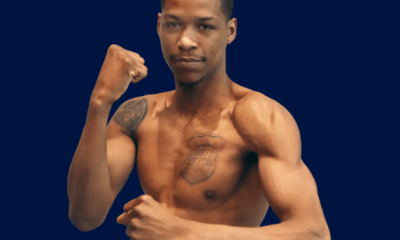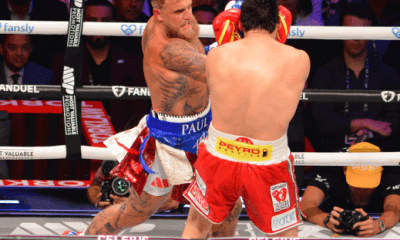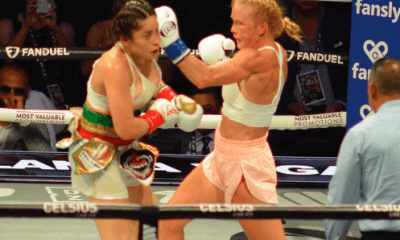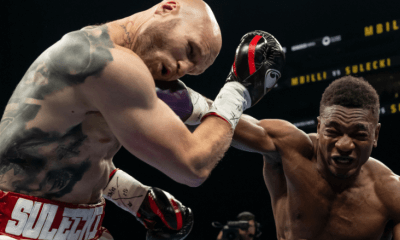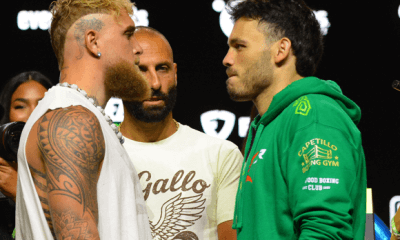Featured Articles
‘How To Box’ by Joe Louis: Part 6 of a 6-Part Series – Putting It All Together
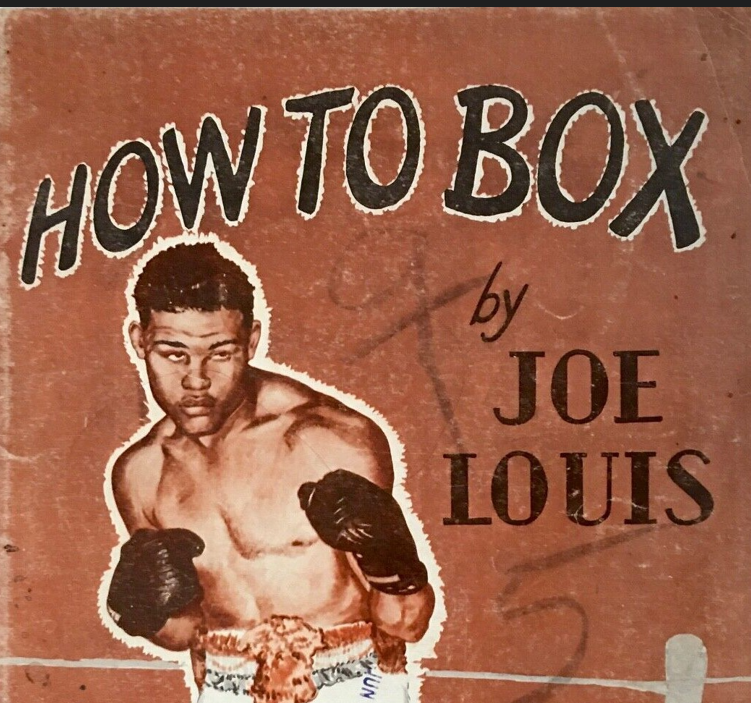
‘How To Box’ by Joe Louis: Part 6 of a 6-Part Series – Putting It All Together
“You got to be a killer, otherwise I’m getting too old to waste time on you.”—Jack Blackburn
Much has been said concerning the Joe Louis duels with Max Schmeling. It was proof that Louis was vulnerable to right hands. It was proof that Louis wasn’t vulnerable to right hands. It was a victory for America over the Nazis. But Schmeling wasn’t a Nazi. It was boxing’s biggest fight. But it wasn’t about boxing. It was what made Louis a hero. But he was already a hero.
One of Abraham Lincoln’s most successful biographers, Roy Basler, wrote that “to know the truth of history is to realize its ultimate myth and its inevitable ambiguity.” Is there a more telling example of this truth in sports than Louis-Schmeling II? Sometimes the tale can obscure the truth. To put it another way: when was the last time you just wondered at it? Wondered at what Joe Louis did to Max Schmeling on a night when, admittedly, the world was on the brink of war and the African-American was on the road to reclaiming himself from the white power structure in the USA? When was the last time you ignored all those very important things and just marvelled at that fight, the recording of which reporter Henry McLemore called “the most faithful recording ever made of human savagery”?
I’m going to invite you here, please, to wonder at it again.
In one moment.
First, we must take a look at Joe’s best performance.
Buddy Baer
The bigger, less celebrated of the Baer brothers had his own rematch with Joe Louis at the beginning of 1942. The first fight had ended in the controversy of a DQ win for Louis and, as he always did when there was the merest hint of scepticism after a title fight, Joe arranged to meet the Giant Californian once again.
A huge man in any era, Buddy tipped the scales at 250 and scraped the ceiling at a little more than 6’6. As noted by the St.Petersburg Times, “a fellow of Baer’s size in good condition, and equipped with the usual quota of arms, legs and eyes must be conceded a chance in any bout, particularly if he has courage and a punch.”
Buddy had both in abundance, but he was not a natural fighter. “We have the feeling he would rather be out picking violets,” is how the Times chose to illustrate the point. While this is a bit much we all know what he means. Louis, who would famously be fighting for free that night in support of the Navy Relief Fund, was a natural gladiator. Buddy Baer was not.
If Max Schmeling is clearly the tougher of the two opponents and Louis wreaked similar havoc on each of them, what is it that makes this Joe’s greatest performance? Baer’s size? Might it be suggested that herein lies the key to arguing Louis the master of all modern super-heavies as he destroys one in this encounter? It’s a reasonable point, but no, it is not that. It was my own favourite line from How to Box by Joe Louis that brought me to this conclusion.
“There are two basic methods of attack,” the1948 manual tells us, “either by force or by skill. The attack by force is used only by the slugger who depends only upon hitting power. The attack by skill is used by the boxer who relies upon his cleverness in feinting, correct leading, drawing and in-fighting.”
This is a fine division, at once elegant and incomplete, of the boxer’s physical abilities versus his technical ability, his gifts as an athlete as weighed against his skill as a boxer. While Joe’s destruction of Schmeling is his most devastating display, he relies often in that short fight upon his natural gifts, his speed, his power. Joe fights ugly for short, vicious stretches against Baer, too, but not before he has demonstrated for us the height of his art.
Louis and his ghostwriter, Edward J. Mallory, describe the various feints Louis employed in his championship years and most interesting among them is the left jab to the body, the lie, and then the right uppercut to the head, the truth. It is a difficult move from a technical perspective, calling upon the weight to be transferred from the left foot to the right and for the fighter to move from long distance to the inside, downstairs to up, all without getting caught. Louis pulls this move off against a fresh Baer, twenty-five seconds into the fight.
Baer came out aggressively and Louis was momentarily crowded out of the fight, driven and harried back to his own corner first by Baer’s length, then his size. Buddy’s physical advantages overcame Joe’s technical superiority, for just a moment. They circle, and Louis takes a short step back, employing the draw, before throwing a nothing left hook. Louis notices that the challenger’s tactic upon being jabbed are to dip, then make a grab and try to tie the champion up on the inside, allowing him to use his size and weight to bear down on him. A fine plan for a big man, but in fact the fight is now lost.
A few seconds later Louis is shuffling back and away from Baer once more and as Baer moves forwards Louis throws another jab. Again, Baer dips and tries to crowd but Louis has no intention of landing the jab. Instead, he holsters his left, takes a step to the outside with his left foot and even as Baer draws himself into his shell and prepares his grab, Louis uncorks his right uppercut, slipping his weight across his body as a part of the natural movement of the punch, the absolute perfection of this skill. The punch is not a finisher but note Baer’s reaction when Louis jabs at him once more, moments later. Instead of trying to menace the champion with his size or a counter, he backs up directly; shy of the uppercut that the jab disguised last time around. This is the ultimate realisation of the feint—to imbue in the jab, a hammer blow at the best of times the virtual attributes of the uppercut. Baer has now to abandon his pre-fight plan for Joe’s most important punch, that jab.
Skill has determined that his superior size is now worthless.
Paraffin to the wound seconds later as Louis pulls the trick off once more, this time after following through on the jab. A right-handed uppercut to the jaw—the hardest punch to land from a technical perspective—turns the trick again and now Baer is hurt. Louis plants a left hook behind the glove just above the ear and then he is ready to unleash the combinations that made him famous.
People say Joe Louis has slow feet. There is something to this, although hopefully it has been explained in the proper context in Part 1—The Foundation of Skill. Even then, however, we discuss his speed relative to those opponents who run. Well footwork is not merely a byword for a foot race. I defy anyone who takes the time to pay close enough attention to the speed at which Louis adjusts his feet now as Baer retreats across the ring to name him slow.
Out of position for a left hook as Baer is going away slightly outside his right foot, Louis shimmies—there is no other word for it—a quick step forwards, channelling all his power through his left leg and hips. This allows him to land that deadly, rare, straight right and behind it, even though he each time has to shimmy and hop forwards, he lands a left hook and then that rolling right cross. With each punch he is covering ground and with each punch he touches down long enough to get the torque through his hips and crack home hard punches, knockout punches. Perhaps the most startling thing about this sequence is that if you press pause at the moment these blows are landing, they look as though Louis were punching from a stationary position. His balance is perfect, his rushing attack is in no way affecting the value of his punches, yet he takes literally no time to get set. He is a cobra packing a shotgun.
“Use the weight of the body in every punch,” (my italics) advises How to Box and it is a tenet Louis is married to. My expectation upon placing it under the microscope was that I would have to issue a warning similar to the one I described when analysing Joe’s straight right hand—that it bore sweet fruit when it worked but that it was too detail-specific to be really viable in the ring, and that countermeasures must be employed. To my astonishment I found that Louis threw power punches (if not always his jab) in this fashion without compromising his balance on offense. It is my suspicion that this is a unique skillset above 200 lbs. and that you would have to work to find fighters who can fight like this in even the smallest divisions.
Though the fight is only a minute old, referee Frank Fullam takes his first close look at Baer as he wobbles back to Joe’s short rope behind a left-right combination to the jaw and a right to the body that Louis lands after ducking into a clinch as Baer tried to throw his first punches in some seconds. Louis is made to miss in turn as Baer bores him back and away from the ropes, missing first with the right uppercut and then the left hook. These are the most difficult punches to remain composed behind, but Louis does so, remaining in punching position.
Head-to-head in a maul, Louis appears the loser as he slowly gives ground during an exchange of meaningless shots, but a split second later, he has moved out of the maul that Baer remains bowed solemnly into, and Louis begins the assault again. A bobbing top caught in two opposing tides—his, and the punches Joe is driving home—Baer’s size is now nothing less than a handicap in the face of the genius of Joe’s box-punching.
For the first knockdown Louis slips the non-existent jab he expects when he is on his way in, jabs to the stomach and bombs a right cross over his defence. Watch carefully and you will see Baer’s high guard rappelled right and down by the famous Louis follow-through before snapping back into place as Baer collapses in an enormous heap on the canvas, forty-pound weight advantage and all, the first time he has looked big since that first uppercut landed.
It’s hard to admire a man shooting fish in a barrel but take a moment to appreciate the blinds being drawn and the man Leroy Simerly (Herald-Journal) called “strictly a sixteen-inch gunner” in full flow.
Baer was magnanimous in defeat clutching Joe’s head in his oversized paws, almost comically huge next to the man labelled in newspapers the following morning as “the most destructive puncher the fight game has ever seen.”
Baer figured Louis to be champion for some time to come.
“Maybe my next child will be a son and I can raise him up to do the job.”
Three days later, Louis would pass his army physical. He would never reach the heights of the Buddy Baer fight again. It is a frightening thought, but it is possible that boxing never saw the very best of its greatest champion.
Max Schmeling
“Ain’t no sense foolin’ around like I did last time.”
Louis said more than once in the run up to the fight that he would end Max Schmeling in a single round. For the most part this was dismissed as hyperbole by a press which did not break ranks to predict anything earlier than a third-round knockout. Hyperbole was the furthest thing from the minds of Louis and Blackburn, however. This was a plan with its foundation built firmly upon the scientific reasoning that Schmeling had become so famous for.
When Joe Louis attended the welterweight title fight between Henry Armstrong and Barney Ross, it was not as a fan, although he was one, but as a disciple. It is possible that Armstrong was the only man in the history of the fight game capable of teaching Louis about controlled destructive violence in the ring, but the story goes that he did—and that along with handler Eddie Mead, he convinced Louis and Blackburn that a direct, rushing assault was the best strategy.
And the story had more than just a hint of truth to it. First Joe was seen at Henry’s training camp and then Henry was seen at Joe’s. Louis did not speak of it directly, but Blackburn was less equivocal:
“Last time Chappie fought just the way Schmeling wanted him to. This time it’ll be different. Chappie’s going to learn from Armstrong. He’s going to set a fast pace right from the start.”
Max Machon, trainer to Schmeling, did not see the danger, encouraging Louis to do just that:
“He would be as awkward as a school girl on her first pair of ice skates!”
Schmeling, meanwhile, wasn’t paying attention or had seen a bluff where there was none:
“I think in the first round we will just feel each other out.”
According to the World Telegram, “Schmeling will make no mistake in strategy. Louis doesn’t know what the word means.” This was the prevailing attitude at the time, but in fact a reversal of this equation was happening right under the noses of the dismissive newspapermen. Even those that sniffed out a possible tactical dimension to the Louis battle plan were disdainful of it. Perhaps they were right, and perhaps Blackburn and Mead were the masterminds behind the directness of the violence about to erupt in Yankee Stadium. But the fact is that Louis had been obsessively watching the first Schmeling fight, originally with a journalist (who could not believe that Blackburn had never shown it to the champion and had in fact discouraged him from seeing it), then with his trainer and finally alone.
Over and over again.
“I know how to fight Max now.”
Louis was to fight Schmeling in the opposite style, as far as How to Box is concerned, to the one he would use to destroy Buddy Baer. There, he fought by skill, here it was to be by force—speed, power.
Louis doesn’t stalk or attempt to draw a lead from Schmeling. At the first bell, he is after him straight away and when Schmeling tries to move, Joe moves with him, still in the small steps and still behind that ramrod jab but with more urgency than is normal. The hard jab and a closet left hook are landed before Max moves out of range, but the leaping left hook he uses to drive Max before him is a new flavor of Louis, especially against an unharmed world-class opponent. Louis had reportedly shadowboxed for forty to fifty minutes before emerging from his dressing room wearing two gowns to keep his body warm. Now he was making both Schmeling and Machon foolish in their pre-fight predictions. Not only was Louis wasting absolutely no time in feeling Schmeling out, but he also bore very little resemblance to a schoolgirl on ice skates. He looked more like coiled galvanized steel brought miraculously and terrifyingly to life.
Referee Arthur Donovan would later claim that this left hook caused Max’s face to swell and changed his pallor to a “faint bluish green.”
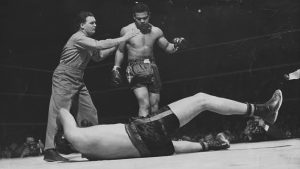
The hook also carried him inside, but rather than moving for space Louis dug his heels in and pushed against Schmeling, denying him room, landing three hard uppercuts, pulling out and then stabbing back in with the one-two. When Schmeling puts his left glove over Joe’s right, cupping his own body protectively with his free arm, Louis reverted to his old habits, making room for himself as he punched, adjusting tactically to Schmeling’s increasingly desperate defensive manoeuvres.
After the German lands his only significant punch of the fight—a right hand as the champion moved away—Louis stalked a rattled Schmeling to the far rope and drew the inevitable pressure lead, before going to work with both hands to the midsection and switching upstairs. When Schmeling tries to hide up close after another one-two, Louis pushes him back and away, giving himself room for his aggressive rushes. Here, then, was the culmination of the tactical switch as he drove Schmeling back with the uppercut then invoked the most famous fistic assault between Dempsey and Tyson, hammering Schmeling back with both fists, the German catapulting away but seemingly caught in the Bomber’s horrifying gravity as he catches the rope for support with his right glove and catapults himself right back into the kill zone. Louis is swarming all over him and Schmeling, now half turned away, is nothing more than a slab of meat and one that the champion goes to work upon in earnest, a butcher wielding two cleavers, finally landing perhaps his most famous punch, a right hand just above the kidney that fractured the transverse process of the third and fourth lumbar vertebrae, tearing the muscles surrounding it in the process. The scream that erupted from Schmeling was “half animal, half human” and according to David Margolick author of Beyond Glory: Max Schmeling and Joe Louis was so bloodcurdling that many patrons on that side of the ring reached for their hats as though compelled to retreat. If it occurred, this was a primal reaction but Louis, for me, was not giving the primal showing of legend.
“He is a jungle man,” wrote journalist Henry McLenmore. “As completely primitive as any savage out to destroy the thing he hates. He fought instinctively and not by any man-made pattern.”
This is not true. Louis had re-armed himself with some new tools for this fight and had shown a strategic surety the German came nowhere near matching—Schmeling was outthought for all that he was also slaughtered. When necessary, Louis switched between pure aggression and his drawing, counterpunching style with seamless ease and although he used his physical rather than his technical brilliance to master Schmeling, I would argue that “the hand of man” is more apparent in this performance than any other one of his fights.
“I thought in my mind, “How’s that Mr. Super-race? I was glad he was hurt,” said Louis in response to questions about his thoughts on the punch that had broken Schmeling’s back. Now he did cut loose, battering Max like he was a heavy bag and indeed from this point on the challenger put up about as much resistance. The final punch, when it came, had the same affect upon Schmeling’s face as a baseball bat would an apple, according to the Herald Tribune. The fight ended in confusion and uproar as first the towel, then Max Machon himself stormed the ring but Schmeling was as knocked out as any fighter had ever been. Louis had wiped the floor with him.
His reward, outside of the $400,000 he had just banked, was to be compared in the next few days in the press to every dangerous animal that walked the earth. Lions, tigers, bears, snakes, hawks and most of all panthers were what the champion was like and the racial climate in which he fought makes us look back and shake our heads at the casual racism. Martin Luther King Jr., Malcolm X and John F. Kennedy were all in America’s glittering future. But I do not think it was a matter of race—or not only of race.
It is a fact, however, that some of the pressmen that talked about Louis in these terms were black.
Louis himself, by virtue of his skill in the ring would take a hand in steering his race toward calmer waters.
It’s us.
We all look at Louis and see something primal because there is something primal within all of us. He speaks to it.
And that’s fine. Boxing needs its violence every bit as much as it needs its heroes. If this series of articles was about anything it was about stripping away that projection, that stardust, that lie and looking at the fighter underneath, because that is a beautiful thing that all too often is overlooked. Louis had one of the best jabs, one of the best skillsets, was one of the best counterpunchers, one of the best boxers at any weight, ever—and I hope I have shown that his supposed tactical rigidity and strategic naivety is something we have projected onto this “animal” this “killer” this “bomber,” too, for all that these were not his greatest strengths. He had help and Blackburn was an important part of arguably the greatest story our sport has ever known but as Joe Louis said, “Once that bell rings, you are on your own.
“It’s just you and the other guy.”
And I sure wouldn’t want to be the other guy.
For those of you who have taken the considerable time to read these articles on Joe Louis from the first word to the last—thank you.
To comment on this story in the Fight Forum CLICK HERE
-

 Featured Articles3 weeks ago
Featured Articles3 weeks agoAvila Perspective, Chap. 330: Matchroom in New York plus the Latest on Canelo-Crawford
-

 Featured Articles2 weeks ago
Featured Articles2 weeks agoVito Mielnicki Jr Whitewashes Kamil Gardzielik Before the Home Folks in Newark
-
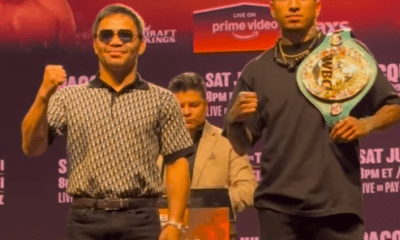
 Featured Articles4 weeks ago
Featured Articles4 weeks agoAvila Perspective, Chap 329: Pacquiao is Back, Fabio in England and More
-

 Featured Articles3 weeks ago
Featured Articles3 weeks agoOpetaia and Nakatani Crush Overmatched Foes, Capping Off a Wild Boxing Weekend
-

 Featured Articles2 weeks ago
Featured Articles2 weeks agoCatching Up with Clay Moyle Who Talks About His Massive Collection of Boxing Books
-

 Featured Articles4 weeks ago
Featured Articles4 weeks agoFabio Wardley Comes from Behind to KO Justis Huni
-

 Featured Articles1 week ago
Featured Articles1 week agoMore Medals for Hawaii’s Patricio Family at the USA Boxing Summer Festival
-
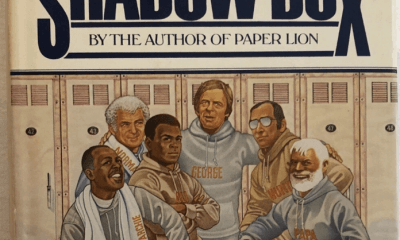
 Featured Articles4 weeks ago
Featured Articles4 weeks agoDelving into ‘Hoopla’ with Notes on Books by George Plimpton and Joyce Carol Oates

